Regional Styles of Painting
In Indian art and culture Regional Styles of Painting, and environmental influences of various places are reflected in the regional painting styles. Italian Renaissance art, for instance, is renowned for its humanism and realistic perspective, whereas Japanese woodblock prints, and vivid colors are the focal points of ukiyo-e. American regionalism, on the other hand, emphasizes local identity and realism to portray rural American life. 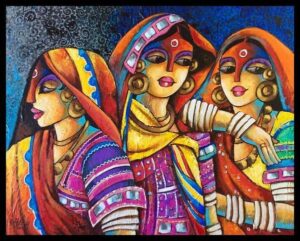
Bright patterns and symbolic meanings rooted in local customs are common in African art. Every regional style reflects distinct aesthetic ideals and principles that are influenced by the sociocultural and geographic environment in which it originated. This variety demonstrates the ways in which art changes in response to various environmental and cultural influences.
Branches and styles that developed in this period Rajasthani style of painting Pahari style of painting.
Rajasthani style of painting
In Indian art and culture, The Rajdhani style of painting is mainly a synonym for the Rajput style of painting, they patronized the dominant ruling class of this period and most of the artists. Artists had arrived from the Mughal gallery to Bikaner, Jodhpur or Kishangarh, people laid the foundation of domestic Rajput styles.
The Deccani Sultanates played a decisive role in the arrival of artefacts from cars, local indigenous artistic traditions influenced these centers even before the advent of Mughal influence. There are also many sub-styles of Rajasthani painting that indicate the confluence of cultures in the Sultanate courts.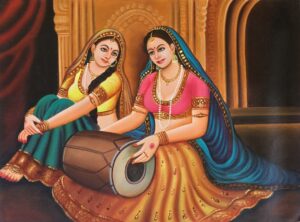
Mewar style of painting is a Regional Styles of Painting
The Mewar state resisted Mughal suzerainty for a long time, accepted Mughal power during the reign of Shah Jahan. The rulers of Mewar continued to promote art even in times of adversity, a notion that blossomed in years of relative peace and prosperity. Such a holding of the seventeenth century is dominated by the painter Sahibadin.
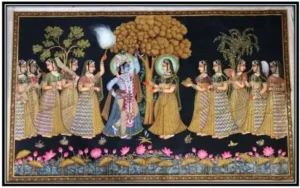
The Mewar Mala of this period was the focus of the Sahibdin of the Ramayana and Bhagavata Purana literary texts. After the death of Sahibdin, the Mewar painting style changed, most of the paintings depicted the court life of Mewar.
Its unique feature is the holding spectacle painting depicting the unprecedented expansion of the formalities of the court and the scenes of the city.
Amer Jaipur style of painting is also a Regional Styles of Painting
Among other kingships closely associated with the Mughals, one was the ruler of Amber, a prominent patron of painting and an avid collector. The Amer style is also called Khojar Sally, his earliest evidence is found in the mural paintings of Bairat, Rajasthan. This style of folk style reached its zenith during the reign of Sawai Pratap Singh in the 18th century.
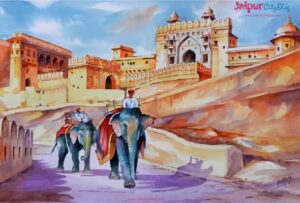
He was a highly religious man and a passionate patron of art, Surat Khana or in the painting department made short drawings to describe the Bhagavata Purana, Ramayana, Ragamala and many image paintings.
Marwar style of painting is a also Regional Styles of Painting
It is one of the most widespread styles of painting, it included Jodhpur and Bikaner ruled by the Rathores and Jaisalmer ruled by the Bhatias. Like Bikaner, Jodhpur was also a desert state prospering through its close contact with the Mughals.
In Indian art and culture, The painting of this period was very extraordinary, he introduced the wide range of Shiva Purana Natcharitar, Durgacharitra Panchatantra with painting.

The painting of Sawant Singh and his beloved Bani Thani in the 17th-18th century Sangad is one of the most romantic that is Udanti and associated with life and myths, romance and devotion. After preserving the early developments in Kishangarh, the focus shifts to the interplay between Sawant Singh Nagaridas and Nihalchand, the painter who painted some of the most famous paintings of this genre.
The woman named Bani Dhani matches Radha’s character, her distinctive outline and lotus-like long eyes, thin lips and pointed chin.His veil or cap defines the outline of his side, it became a unique painting associated with the Kishangarh style is a Regional Styles of Painting
Bundi style of painting is a Regional Styles of Painting in Indian art and culture
The twin princely states of Bundi and Kota were collectively known as Hadoti.
These twin princely states, formed by the division of the old Bundi kingdom between the two brothers, had a closely related history and artistic tradition. During Shah Jahan, in 1631 AD, Madho Singh, son of Bundi King Rao Ratan Singh, was given a separate state of Kota and made him independent from Bundi, since then Kota came into existence as an independent state.
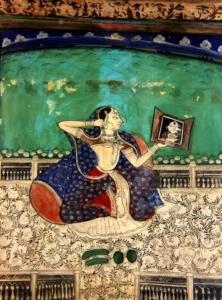
Kota was earlier under the control of Kotia Bhil which was killed and captured by Chaitra Singh, grandson of Deva, the founder of the Chauhan dynasty of Bundi. He declared himself the sole representative to rule on behalf of God, the real king, playing a role in his Krishna devotion.
Elaborate paintings of local vegetation are presented in the Bundi style, in which the new face is round with a sharp nose. The sky is painted in different shades and a red ribbon appears in the sky.
Rajput style is also a Regional Styles of Painting
Initially based on graffiti and Franco, the format of miniature painting became dominant in later times. It is generally devotional and religious in nature, using Hindu symbols such as lotus, peacock and swan. The 17th to 18th century was the dominant period.
Mughal style in In Indian art and culture
This is based on the Iranian miniature painting style, it portrays the Mughal ruler and his home family in general, the majestic chic war and hunting scenes are also very popular. In these the focus is on the person in the picture, on the trees, birds and bird’s 16th to 18th century.
Pahari painting style is a Regional Styles of Painting
This style of painting developed in the sub-Himalayan kingdoms under Mughal influence from the 17th to the 19th centuries, Rajput styles that came under Pahari painting.
The galleries of the courts of about 22 princely states spread from Jammu to Almora were included. Two of the greatest painters of this genre, Nainsukh and Manku, three important personalities of the Pahari style, Nainsukh Manku Sansar Chand.
Basoli style is a Regional Styles of Painting
The painting of the Bahadi school in the seventeenth century is related to the miniature painting given from Basoli in Jammu and Kashmir. This was the initial phase and was characterized by large eyes resembling lotus petals and a expressive face with a line of low moving walls.
This style used the vocal technique of illustration on clothing, but it developed its own style and technique The first patron of this style was King Kirpal Pal. The most famous painter of this style was Devidas.
Kangra Style is a Regional Styles of Painting
After the decline of the Mughal Empire, many artists trained in the Mughal style migrated to the Kangra region of Himachal Pradesh, in 1774 they got patronage from the Rajput kings, this gave birth to the Guler Kangra style of painting. First of all, development took place in Guler, then it came to Kangra, this style reached its culmination under the protection of King Sansar Janma.
The specialty of his painting was sensitivity and intelligence, which other styles lacked, the most popular subjects were Geetagonda Bhagavata Purana, Bihari Lal’s Satsai and Naal Damayanti. All the paintings also have other worldly expressions about them.
The second very famous group of paintings is that of 12 flute playing months or perennials.The Kangra style became the parent style of other galleries to be developed in the court of Kullu, Chamba and Mandi. Kangra style of painting can be seen in the Kangra Stablesh Sansar Chand Museum.
Ragamala Painting is a Regional Styles of Painting
Ragamala Painting is also a series of illustrative paintings of important carpet India based on ragamala or garlands of ragas depicting heroic Indian music ragas This is the classical form of art in mediaeval India as a classical and holding of the blending of poetry and classical music.
Ragamala paintings were created in most styles of Indian painting beginning in the sixteenth and seventeenth Ragamala paintings, beginning in the century, today they are named as Pahari Ragamala, Rajasthan or Rajput Ragamala, Decani Ragamala and Mughal Ragamala.
Regional Styles of Painting, each raga is explained in a particular sense in a colour describing the story of the hero and heroine, it also describes the season and the time of day and night in which a particular raga is sung. Many paintings demarcate specific Hindu deities associated with Rama, from Bhairav or Bhairavi to Shiva series to Devi etc. The six major ragas present in Ragamala are: Raga Bhairav, Deepak, Sri Malkosh, Mag and Hindola.
conclusion
Regional Styles of Painting styles provide a diverse range of artistic expression, influenced by their distinct cultural, historical, and environmental backgrounds In Indian art and culture. Regional Styles of Painting offer insight into the beliefs, customs, and experiences of other cultures in addition to showcasing the various techniques and aesthetics created worldwide. Regional Styles of Painting.
Regional Styles of Painting We obtain a greater understanding of the world’s creative legacy and the ways in which art both represents and shapes society by studying various regional forms. In the end, these various approaches highlight the innate human need to express, understand, and rejoice in the universe via artistic imagination.
